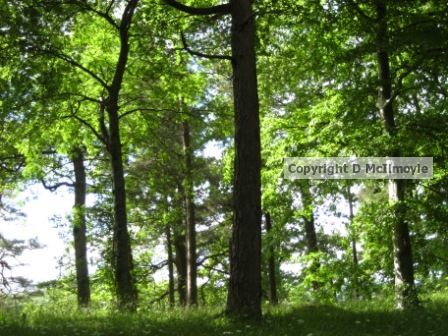I honestly don’t think anyone knows who’s going to read their blog until they get writing it. This one is mostly read by folks with a storytelling bent, whether it’s a local with a romantic soul, a teacher or volunteer guide looking for history’s interesting bits, a journalist, a whole load of spammers telling tales about loans and boots and yachts, a writer of novels, a politician, an historian, a neighbour, or a lover of the discipline of local history, wherever it is found.
If you love stories, I can’t recommend a better source of inspiration than a map and a copy of Diana Whaley’s Dictionary of Lake District Place-Names (which actually includes much more of Cumbria, not just the Lake District) or Ekwall’s Concise Oxford Dictionary of English Place-Names. There are other books on place names, but a lot of them aren’t very well researched, so do yourself a favour and invest in a good one. So: see that picture? This is Cockshot Woods at Keswick, but there are several others in the county with the same name. ‘Cocke shott, the Cockshott 1677, 1746… Cockshot Point 1851… a glade or path in woodland “through which woodcocks, etc, might dart or ‘shoot’ so as to be caught by nets stretched across the opening” ‘ (Whalley) And this very famous view, of Cat Bells (or Catbells, depending on your map). That’s the mountain, for people not familiar with it!
‘Catbel(close) 1454… Catbels 1794… “the bell-shaped hill frequented by wild cats”… the two summits could explain the plural name.’ (Whaley) And now, let’s shoot back in time to something rather less ‘oh, of course!’. This is Derwentwater, a lake fed by the River Derwent; there are a number of rivers Derwent around the country, all with the same derivation. ‘(River:) Derventione (applied to Roman fort at Papcastle, on the Derwent), Deruventionis fluvii, 8th century… possibly Derwennydd, late 6th-early 7th century… Derwentfelles 1256… Darwen Isle 1695… Derewentewatre, Derwentwater early 13th century. “(River) with oak trees” traditionally explained from British *derwa “oak” plus suffixes… the names may be still more ancient, ascribably to an “Old European” stratum’ (Whaley)
‘Derwent R, Cumberland [Deruuentionis fluui c 730 Bede, Deowentan stream c 890 OEBede, Derwent] … A British river-name Derventio… derived from the British *derva “oak”, Welsh derw &c. The name means “river where oaks were common”…. From Derwent Cumberland are names Derwent Fells [Derewentfells 1292] and Derwentwater [Derewentewater 1210, Derewentewater 1243].’ (Ekwall) There are lots of beautiful, old oaks around Derwentwater still, many of which must be several hundred years old. Descendants of the oaks of Derventio, I hope.
Copyright D McIlmoyle 14.04.2014




Ah, the romance of placenames (even though spellcheck keeps telling me to separate out the components as ‘place names’). A wise caveat about those substandard reference books, especially the touristy guides with their misleading folk etymologies.
Hi there – yes, I love them, even if I keep having to tell people that Witch Wood is in fact Wych (Elm) Wood. Probably 😉
Penrith was thought by antiquarians to mean ‘red hill’ which makes eminent sense if you look at it from here, as it’s definitely got a big round hill and the soil – especially if uncultivated – is bright, orangey red. However, modern etymology has trashed that in favour of ‘chief ford’. It sounds less interesting until you think about it – and it means that this little spot was a major route north/south for, well, forever.
Thanks for coming over!
To me, living in Wales, the ‘chief ford’ (Pen-rhyd) explanation seems eminently apt. Meanwhile, in Gloucester and surrounds placenames with ‘witch’ and the like could well refer to the Hwicce. Just goes to show that placename studies are not for the fainthearted!
Indeed! Especially as many of those hwicce places could just be wych elms, too… still, fertile territory for storytellers, and what’s life without a story? 😀